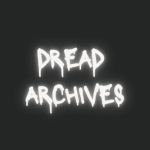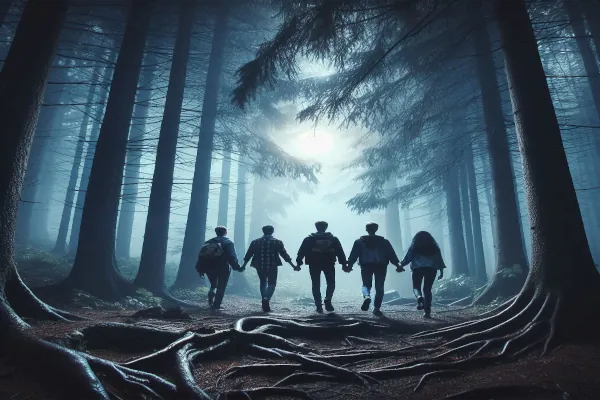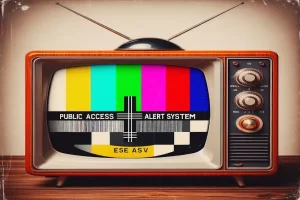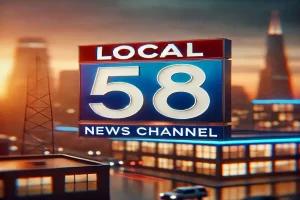In recent years, analogue horror has emerged as a captivating and chilling subgenre that has taken modern horror to new, unsettling heights. This genre taps into our primal fears by harnessing the imperfections of retro technology, like VHS tapes, CRT televisions, and old radio broadcasts, to create an atmosphere of tension, mystery, and dread. While technology continues to advance, the eerie, decaying nature of analogue media has sparked a resurgence of interest in the genre, drawing both nostalgia and fear from audiences.
Analogue horror is distinct in its ability to manipulate the limitations of outdated technology to craft an atmosphere that feels both familiar and deeply wrong. The grainy visuals, distorted sounds, and eerie glitches become tools for building tension and unease, leaving viewers feeling like they are witnessing something forbidden or lost to time.
In this post, we’ll explore the origins of analogue horror, diving into its history and influences, and uncovering why it has become such a powerful tool for creating spine-chilling terror in the modern age. Get ready to explore how this unique subgenre taps into both nostalgia and fear, and why it’s resonating so strongly with audiences today.
What Is Analogue Horror?
Defining Analogue Horror
Analogue horror is a subgenre of horror that thrives on the unsettling qualities of outdated, analogue technology. By utilizing vintage media, such as VHS tapes, CRT televisions, and analog audio equipment, it creates an atmosphere of eerie nostalgia combined with discomfort. The technology itself becomes a crucial part of the storytelling, with its inherent imperfections—like static, glitches, and distortion—serving as tools to amplify fear.
Unlike other horror subgenres, which may rely on supernatural or psychological elements, analogue horror uniquely uses the malfunctioning nature of old tech as a narrative device. It often evokes a sense of unease by presenting familiar objects in a strange, corrupted form, making the viewer question reality. The degraded quality of the media brings an added layer of terror, as the grainy visuals and warped sounds tap into our subconscious fear of the unknown and the forgotten.
Key Characteristics of Analogue Horror
At its core, analogue horror is defined by several distinctive characteristics. One of the most prominent features is the use of distorted visuals—flickering, grainy footage that often obscures key details, forcing the viewer to rely on their imagination. This lack of clarity increases the tension, making it feel as though something is hidden or lurking just out of sight.
Another essential aspect of analogue horror is the presence of audio glitches or distortions. Whether it’s a warped voice, a hiss of static, or the odd hum of malfunctioning equipment, these sounds create a sense of disorientation. The corruptions in the audio and visuals blend together, amplifying feelings of unease and making even simple moments feel ominous.
The theme of “found footage” also plays a significant role in analogue horror. The idea that the viewer is watching something discovered or hidden—like a VHS tape from an unknown source or a corrupted broadcast—contributes to the overall sense of something forbidden or lost. This narrative device, paired with the imperfect medium, suggests that the horror you’re experiencing is real, something that’s been preserved in time, only to be uncovered long after the fact.
These elements combine to create an atmosphere that feels both unsettling and nostalgic, drawing the viewer into a world where technology itself becomes the source of terror.
The Early Beginnings of Analogue Horror
The Influence of 1980s and 1990s Horror
The roots of analogue horror can be traced back to the 1980s and 1990s, a time when VHS tapes and early cable TV were ubiquitous in homes across the world. This era marked the peak of home video, and the gritty, low-fi aesthetics of VHS became deeply intertwined with the horror genre. Many of the horror films from this time embraced a style that would later become a hallmark of analogue horror: the “found footage” format. These films used the concept of discovered, unedited footage to blur the line between reality and fiction, which made them feel more authentic and unsettling.
Movies like The Blair Witch Project (1999) and The Ring (1998) capitalized on this aesthetic, presenting their stories as if they were real, often utilizing grainy, amateur-looking footage to give the impression that viewers were watching something forbidden or hidden. This approach added an extra layer of realism and dread to these films, which laid the groundwork for the analogue horror genre we know today. The sense that the audience was watching something that had been “found” rather than scripted fostered an immersive experience, where the horror felt closer and more immediate.
The VHS Boom and Cultural Impact
The 1980s and 1990s also saw the rise of VHS tapes, which became a defining cultural phenomenon. VHS tapes weren’t just a medium for watching movies—they represented a shift in how people consumed media. With VHS, horror films became more accessible, allowing viewers to collect, share, and even “discover” obscure or underground movies. This democratization of media viewing helped to create a sense of intimacy and realism that wasn’t found in traditional theatrical releases.
VHS tapes, along with public access TV programming, carried an aura of mystery. These formats were often seen as “untamed” media—recorded on personal machines, sometimes corrupted by time, and not subject to the polish of commercial broadcast. It was in this environment that VHS tapes, particularly those of horror films or odd, unknown broadcasts, gained a reputation for carrying a sense of danger or the unknown. The deterioration of tapes over time or the distortion of signals on older TVs became a natural companion to the growing sense of unease and unpredictability in the horror genre.
In this atmosphere, horror began to evolve from simply being about fictional monsters or supernatural entities to exploring the terror of the everyday. The sight of a corrupted VHS tape or the eerie buzz of a malfunctioning CRT television became symbols of something larger—something lost, forgotten, and perhaps dangerous. The combination of these cultural and technological shifts provided the perfect breeding ground for the analogue horror genre to emerge in the years that followed.
Why Retro Technology Is Scary: The Fear of the Old and Obsolete
The Aesthetic of Decay
Retro technology in analogue horror is not just a visual or auditory tool—it’s a conduit for a deeper, primal fear of decay. As VHS tapes, CRT televisions, and cassette players age, they begin to show signs of deterioration: the graininess of the image, the crackling of the audio, the random static that interrupts a broadcast. These imperfections, though once common, now evoke a sense of unease and uneasiness. There is a discomfort in watching something that was once pristine but is now fading, hinting at the passage of time and the inevitable decline of all things.
In analogue horror, this degradation of technology becomes a metaphor for something more sinister. The static, glitches, and warped visuals are not merely technical flaws—they reflect the breakdown of the world within the story, mirroring the unraveling of reality itself. Viewers are confronted with the unsettling idea that the media they are watching is in a state of collapse, suggesting that something ancient or hidden is surfacing, but in a form that is distorted and incomplete. It is a tangible manifestation of fear that relates to obsolescence—an encounter with something that no longer functions as it was meant to, yet refuses to disappear.
This concept taps into a universal fear of obsolescence. The viewer is not simply interacting with an old device; they are witnessing something from a forgotten era, a piece of history that has slipped through the cracks of time. The idea that something so once commonplace can be lost to time—and now only emerge as a fragment, damaged and incomplete—resonates deeply. It evokes a nostalgia for the past, yes, but also a terrifying sense of being left behind by progress.
The Uncanny Valley of Old Technology
The “uncanny valley” is a psychological concept that refers to the unease or discomfort we feel when something that is almost, but not quite, human or familiar, is altered in a disturbing way. Think of a human figure with exaggerated features or a robot with lifelike eyes—there’s something about it that doesn’t quite sit right with us. The same discomfort is at play in analogue horror, where the technology itself distorts or “malfunctions” in ways that evoke both familiarity and terror.
This distortion often happens with the visual and audio components of analogue devices, making things look or sound strange while still maintaining some level of recognizability. A familiar image on a screen might warp, glitch, or flicker, making it look almost human but in an unnatural, grotesque way. Similarly, a voice might distort and sound unsettling, as if something once familiar has been twisted beyond recognition.
Analogue horror thrives on this sense of the uncanny because it plays on two distinct emotions: nostalgia and terror. The viewer may recognize the technology, such as an old VHS tape or a fuzzy TV broadcast, but when these devices malfunction, they reveal a darker, more disturbing side. The video or sound begins to feel more “alive,” as if it’s an entity that has gained a kind of autonomy, but it is no longer entirely human or safe. This distortion evokes a sense of horror that is both psychological and visceral, as the viewer is forced to confront the horrifying consequences of interacting with something both familiar and deeply wrong.
By manipulating the “uncanny valley” effect, analogue horror taps into our subconscious discomfort with the malfunctioning of the familiar. It heightens the eeriness by turning something once ordinary—like watching TV or listening to a tape—into an experience that feels wrong, almost as if the device itself is malfunctioning due to supernatural forces. This unnerving sense of dissonance between the past and the present amplifies the terror of analogue horror, making it an especially powerful tool for creating fear.
The Blair Witch Project and Its Influence
The Groundbreaking Use of Found Footage
Released in 1999, The Blair Witch Project became an instant cultural phenomenon and remains one of the most influential films in the horror genre. At the time, its use of “found footage”—a narrative style in which events are presented as though they were discovered recordings—was groundbreaking. This technique had a profound effect on the way horror was presented, particularly in the realm of analogue horror.
The film’s raw, documentary-style approach created a chilling sense of realism. The shaky cam, the grainy footage, and the lack of clear answers within the plot all contributed to the feeling that the events unfolding on screen were unfiltered, unedited, and “real.” This made the terror more immediate, as viewers were led to believe they were watching actual footage recovered from missing filmmakers. The ambiguity surrounding the supernatural elements, coupled with the disorienting, low-tech visuals, made The Blair Witch Project a haunting experience that felt less like fiction and more like a disturbing glimpse into the unknown.
The Influence on Analogue Horror
The success of The Blair Witch Project played a pivotal role in the development of analogue horror as a subgenre. The film demonstrated how the imperfections of analogue media—such as grainy video, static interference, and “unprofessional” cinematography—could be used to create an atmosphere of fear and unease. Its ability to blend documentary-style realism with supernatural horror opened the door for future creators to experiment with low-tech visuals and unreliable narratives in new and exciting ways.
Much like The Blair Witch Project, analogue horror often thrives on the ambiguity of what is real and what is imagined. It embraces the idea of “found footage,” allowing viewers to uncover disturbing, often incomplete media—whether it’s a mysterious VHS tape or a corrupted TV broadcast. This aesthetic, which has become a hallmark of the genre, builds tension through the concept of lost or forgotten media, much like the footage in The Blair Witch Project that was “found” after the filmmakers’ disappearance.
Furthermore, the film’s focus on a slow burn of terror, where horror builds gradually through tension rather than explicit scares, has heavily influenced how analogue horror creators approach storytelling. Instead of relying on jump scares or overt supernatural events, analogue horror often utilizes the unsettling qualities of the medium itself—distorted audio, flickering visuals, and broken footage—to create an atmosphere where dread is in the details. The unsettling silence or the sudden distortion of sound in The Blair Witch Project is reflected in many analogue horror works, where the malfunctioning technology itself becomes a source of terror.
Legacy and Cultural Impact
Beyond its immediate influence on the horror genre, The Blair Witch Project helped redefine how horror could be marketed and consumed. The viral marketing campaign surrounding the film, which blurred the line between fiction and reality, mirrored the approach of analogue horror creators who thrive on the idea of uncovering forgotten, cryptic media. The film’s legacy is seen not only in the rise of found footage films but also in the flourishing of web-based horror series, podcasts, and games that rely on analogue aesthetics.
In the years following The Blair Witch Project, films like Paranormal Activity (2007) and REC (2007) continued the found footage tradition, incorporating the same low-fi aesthetic and storytelling techniques. These works, along with the growing popularity of online horror series, set the stage for the current wave of analogue horror, where creators use the limitations of retro technology to enhance their stories and intensify fear.
The success of The Blair Witch Project demonstrated the power of analogue media in horror storytelling, not just as a tool for creating scares but also as a way to evoke a sense of authenticity and unease. Its influence can be seen in the ongoing trend of analogue horror, where the imperfect, decaying nature of vintage technology continues to terrify and captivate audiences.
Conclusion
Analogue horror, which emerged from the fusion of nostalgia and unease over outdated technology, has grown from a niche subgenre into a powerful force in modern horror. Its roots trace back to the 1980s and 1990s, where VHS tapes, grainy TV broadcasts, and the low-fi aesthetic became the backbone of terrifying tales. Influenced by films like The Blair Witch Project and a desire to replicate the tactile imperfections of analogue media, the genre has evolved into a unique storytelling medium that captures both the fear of the unknown and the allure of the past.
What makes analogue horror so effective is its ability to tap into primal fears. Retro technology, with its inherent flaws—distorted visuals, warped sound, and static interruptions—mimics the uncanny feeling of something familiar, yet just out of reach, or worse, dangerously wrong. This form of horror doesn’t rely on gore or overt supernatural elements; instead, it builds tension through the eerie presence of malfunctioning technology, inviting viewers to experience a world that feels both real and disturbingly off-kilter.
The continuing relevance of analogue technology in horror speaks to its power to immerse audiences in a world that is both nostalgic and unsettling. The sense of authenticity that analogue media creates is unmatched in modern digital storytelling, where everything can feel too polished or distant. In analogue horror, every glitch, every flicker, every warped tape adds layers to the narrative, pulling viewers into the nightmare itself. Whether through disorienting found footage, deteriorating VHS tapes, or haunted radio broadcasts, the genre provides an intimate, visceral experience that digital media struggles to replicate.
If you haven’t yet ventured into the world of analogue horror, now is the perfect time to explore it. Dive into YouTube series like Local 58, discover the chilling worlds of games like The Dark Occult, or watch the classic analogue horrors that continue to influence the genre. Experience the retro nightmare for yourself and understand why analogue horror remains one of the most immersive and terrifying forms of modern horror. The past may be decaying, but it still has the power to frighten us like nothing else can.




